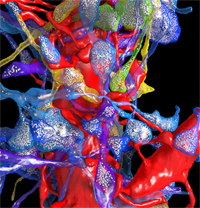Monday, 8 August 2016
A Nanometric 3D Representation of a Mouse Cortex Cortex
 The analogy between a real forest and a “forest of neurons” has been drawn many times, but the images produced most recently by the team of Jeff Lichtman and Narayanan Kasthuri (see the first two links below) make it clear yet again that the complexity of the brain’s connections far surpasses that of the densest forest.
The analogy between a real forest and a “forest of neurons” has been drawn many times, but the images produced most recently by the team of Jeff Lichtman and Narayanan Kasthuri (see the first two links below) make it clear yet again that the complexity of the brain’s connections far surpasses that of the densest forest.
As Lichtman has long said, by going down to the scale of the electron microscope and then reconstructing the slightest contacts between axons, dendrites, and neighbouring glial cells slice by slice, we can detect patterns that escape us at the more “macro” scales previously used to model neuronal connectivity.
If you want the proof, just go view the videos of the cortex of a mouse brain at the first and third links below. The first difference you may notice between this neural forest and a real one is that there are no empty spaces between the branches here. All of the space is filled with these cell extensions in contact and inextricably intertwined with one another. One big advantage of these computer-based, 3D reconstructions is that you can make any given type of cell appear or disappear, so that you can, for example, display only certain types of axons (myelinated or not), or certain types of dendrites, or certain types of glial cells (astrocytes or oligodendrocytes, etc.) but not others.
In the first of these videos, which presents the method used to create these spectacular 3D images, Lichtman reminds us that in accordance with Peter’s law (not to be confused with the Peter principle of incompetence, which is something entirely different), scientists long believed that if one knew the position of one axon and one dendrite with sufficient accuracy, one could deduce the areas of contact forming the synapses between them. But that is unfortunately not what Lichtman’s images show. Instead, they reveal an irregularity that can be resolved only with a better knowledge of the molecular properties of the axons and the dendritic spines.
Thus, as often happens in science, a major advance demands that the questions at hand be analyzed at an even finer level. This may seem discouraging, but as Lichtman says at the end of the video, there has never been a case in biology where knowing more was worse than knowing less. Or, to repeat a famous citation from Katz and Rosenzweig that I have included in an earlier post and that captures the very essence of the scientific method:
We have not succeeded in answering all our problem. Indeed we sometimes feel we have not completely answered any of them.
The answers we have found have only served to raise a whole set of new questions.
In some ways we feel that we are as confused as ever, but we think we are confused on a higher level and about more important things.
![]() 3D brain map reveals connections between cells in nano-scale
3D brain map reveals connections between cells in nano-scale
![]() Saturated Reconstruction of a Volume of Neocortex
Saturated Reconstruction of a Volume of Neocortex
![]() Video: An incredibly detailed tour through the mouse brain
Video: An incredibly detailed tour through the mouse brain
From the Simple to the Complex | Comments Closed








